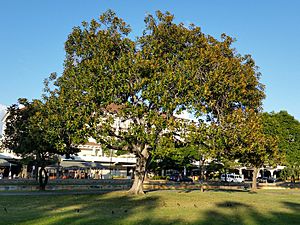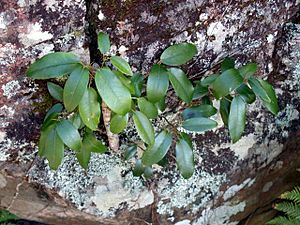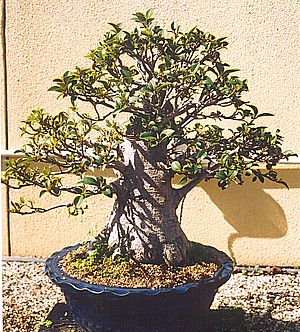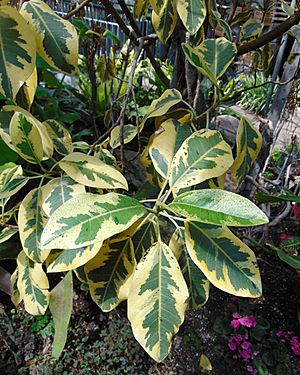Rusty fig facts for kids
Quick facts for kids Rusty fig |
|
|---|---|
 |
|
| Scientific classification | |
| Genus: |
Ficus
|
| Species: |
rubiginosa
|
 |
|
| Range in Eastern Australia (in green) | |
The rusty fig or Port Jackson fig (its scientific name is Ficus rubiginosa) is a type of flowering plant that grows naturally in eastern Australia. In the Dharug language, it's called damun. This tree often starts growing on other plants or rocks. As it gets older, the rusty fig can become a large tree, reaching up to 30 meters (about 100 feet) tall. It has a wide trunk with special roots called buttress roots. Its leaves are shiny green and shaped like an oval.
The fruits of the rusty fig are small, round, and yellow. They can turn red when they are ripe, which happens all year, but mostly in spring and summer. Like all figs, the fruit is actually a special kind of flower called a syconium. Tiny flowers grow inside this fruit. The rusty fig needs a specific type of fig wasp called Pleistodontes imperialis to help it make seeds. Many birds and animals, like pigeons and parrots, love to eat these fruits. You can find the rusty fig growing along the east coast of Australia, from Queensland down to Bega in southern New South Wales. It often grows where rainforests meet other areas or on rocky places. People also plant it in parks for shade, or grow it indoors, and even use it for bonsai (miniature trees).
Contents
What's in a Name?
The rusty fig was first described by a French scientist named René Louiche Desfontaines in 1804. He found a sample of the plant from "New Holland" (which is what Australia was called back then). The name rubiginosa comes from a Latin word meaning "rusty." This is because the underside of the leaves often has a rusty color. That's why it's also called the "rusty fig." Other common names include "Illawarra fig" and "Port Jackson fig." The local Aboriginal people, the Eora and Darug, called it damun.
Scientists have studied the DNA of the rusty fig. They found that it is closely related to other fig trees that grow in rainforests or on rocks in dry parts of Australia.
How to Spot a Rusty Fig
When it's fully grown, the rusty fig is a wide tree that provides a lot of shade. It can grow over 30 meters (about 100 feet) tall, but in the Sydney area, it's usually around 10 meters (33 feet). The trunk is wide at the bottom, like it has "buttresses," and can be 1.5 meters (5 feet) across. The bark is yellowish-brown.
This fig tree can also grow on other plants (called a hemiepiphyte) or on rocks (called a lithophyte). Its leaves are arranged alternately on the branches. They are egg-shaped or oval and can be from 4 to 19.3 centimeters (1.6 to 7.6 inches) long. They can be smooth or have tiny rusty hairs.
The fruit of the rusty fig is actually a special kind of flower called a syconium. Inside this hollow fruit are tiny male and female flowers. The figs often grow in pairs and are yellow at first, about 4 to 10 millimeters (0.16 to 0.39 inches) wide. When they ripen, they turn red and have a small bump at the tip. They grow on a short stalk. Fruits can ripen all year, but you'll see more of them in spring and summer. Sometimes, a tree will have both ripe and unripe fruits at the same time.
The rusty fig looks a lot like its cousin, the Moreton Bay fig (F. macrophylla). They grow in similar areas, so people often mix them up. But the rusty fig has smaller leaves, shorter fruit stalks, and that special rusty color on the underside of its leaves. It can also be confused with the small-leaved fig (F. obliqua), but the small-leaved fig's fruits are even tinier.
Where Rusty Figs Grow

The rusty fig grows all along the eastern coast of Australia. You can find it from the very top of the Cape York Peninsula in northern Queensland down to Bega in southern New South Wales. It also grows further inland in some areas. You can see rusty figs growing as regular trees, or on other plants, or on rocks, all in the same place.
Rusty figs like to grow in rainforests, at the edges of rainforests, in valleys, along riverbanks, and on rocky hillsides. They often start growing in cracks in rocks or even in brick walls where seeds have landed. The soil they grow in is usually well-drained and doesn't have a lot of nutrients. In the Sydney area, they grow from sea level up to 1000 meters (about 3300 feet) high.
Outside of Australia, the rusty fig has started to grow naturally in cities like Melbourne and Adelaide, as well as in New Zealand, Hawaii, California, and parts of Mediterranean Europe.
Rusty Fig and Other Living Things
Many animals eat the fruit of the rusty fig. These include different kinds of birds like the rose-crowned fruit-dove, wompoo fruit-dove, wonga pigeon, topknot pigeon, and various parrots. Mammals like the grey-headed flying fox also enjoy the fruit. The rusty fig is an important food source for the endangered Coxen's fig parrot. Many fruits fall to the ground, but animals that eat them also help spread the seeds.
Tiny insects called thrips sometimes feed on the underside of new rusty fig leaves. This can make the leaves curl up and look distorted. Other tiny insects called psyllids have also caused trees to lose almost all their leaves in places like the Royal Botanic Gardens in Sydney.
The special fig wasp, P. imperialis, which helps the rusty fig make seeds, traveled from Australia to New Zealand between 1960 and 1972. Because of this, rusty fig trees in New Zealand, which couldn't make seeds before, started growing from seeds in walls and on other trees. These wasps have also been taken to Hawaii, California, and Israel, where they help the fig trees grow.
Rusty fig trees can live for 100 years or more. They can even grow back after a bushfire and start producing fruit again within three years.
Life Inside the Fig Fruit
The fig fruit (syconium) is like a tiny home for many different kinds of wasps. Most of these are the pollinator wasps that help the fig make seeds. These wasps grow deep inside the fruit, which keeps them safe from other insects. There are also at least 14 other types of wasps that live in the fig, but they don't help with pollination. Some of these wasps are parasites, meaning their young eat the young of the pollinator wasps.
Tiny worms called nematodes also live in the fig fruits and sometimes inside the pollinator wasps. The rusty fig is home to two types of these nematodes.
Growing Rusty Figs

The rusty fig was first grown in gardens in the United Kingdom in 1789. Today, it's a popular ornamental tree in eastern Australia, New Zealand, Hawaii, and California. In some places, it's even considered an invasive species because it spreads easily. It's great for providing shade in parks and on golf courses.
Compared to some other fig trees, the rusty fig doesn't spread as much, so it's good for places like parking lots or suburban streets. However, its roots can grow large and sometimes cause problems, and its bark is thin and can be easily damaged. It can grow in both acidic and alkaline soils and can reach about 10 meters (35 feet) tall in 30 years. If you plant trees about 8–12 meters (30–40 feet) apart, their branches will eventually grow together to form a continuous cover. These trees are very valuable because they provide fruit for birds and mammals, but they do drop a lot of fruit and leaves, which can make a mess.
There's a special type of rusty fig called a "variegated" form. Its leaves have irregular patches of yellow and green because some parts of the leaf lack the green color (chlorophyll). Leaves that grow in winter usually have more green than those that grow in summer. Sometimes, branches with all-green leaves will appear on these variegated trees.
Even though its leaves are quite large, the rusty fig is very popular for bonsai (the art of growing miniature trees). It's easy to work with and hard to kill. You can make the leaves smaller by pruning them in early summer. Many people say it's the best tree for beginners to try bonsai with, and it's one of the most common native trees used for bonsai in Australia. Its bark stays smooth and doesn't get a rugged, old look. There's also a narrow-leaved form called "Little Ruby" that's grown in gardens.
The rusty fig is also a good houseplant for places with low, medium, or bright light. The variegated form needs brighter light. It has even won an award from the Royal Horticultural Society for being a great garden plant. It's easy to grow new plants from cuttings or by a method called aerial layering.
The wood of the rusty fig is light-colored, soft, and breaks easily. It's lightweight and can be used to make small things like toys or boxes.
See also
 In Spanish: Higuera de Puerto Jackson para niños
In Spanish: Higuera de Puerto Jackson para niños




